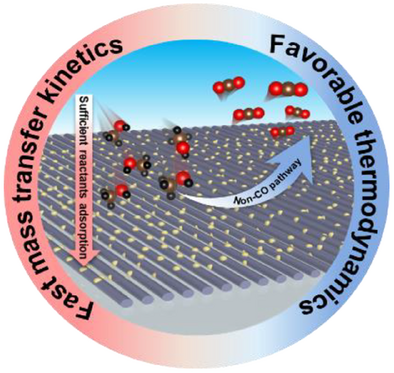A Powerful Regulator to Enhance Electrocatalytic Reaction Kinetics and Thermodynamics: The Ordered Hetero-Nanowire
Graphical Abstract
A novel ordered hetero-nanowire (NW) regulator is presented, which simultaneously couples the merits of the kinetics and thermodynamics in electrocatalysis. The periodical arrangement enables the formation of the local electric field to improve mass transfer kinetics, accounting for a significant boost in MOR performance. In addition, the hetero-NWs undergo the energetically favorable non-CO pathway, which is not susceptible to the invasion of toxic carbonaceous intermediates and thus ensures long-term durability for MOR.
Abstract
Optimizing the thermodynamics of electrode reactions is a valid strategy for achieving superior electrocatalysts for direct methanol fuel cells (DMFCs). However, as the catalyst downsizes to the nanoscale, the influence of mass transfer kinetics is pronounced in improving electrocatalytic activity. Herein, an ordered hetero-nanowire (NW) regulator that couples the virtues of kinetics and thermodynamics is reported. Finite element analysis demonstrates that the periodic arrangement of hetero-NWs could construct a uniform electric field, promoting the precise mass transfer of reactant molecules and accelerating the electrode reaction kinetics for the methanol oxidation reaction (MOR). In addition, the microscopic electronic structure effect of the well-defined catalyst weakens the bonding interaction toward toxic carbonaceous intermediates, which meanwhile strengthens the adsorption of hydroxyl species, critically contributing to enhanced MOR durability. The wide generality of this regulator has been confirmed by a series of as-prepared ordered hetero-NW catalysts, which show prominent electrocatalytic performance, including relatively high mass activity, superior CO resistance, and long-term stability. Therefore, this work reveals the importance of the tandem effect of kinetics and thermodynamics in electrocatalysis, which provides valuable insights for developing customized and highly efficient catalysts for extensive applications.
Conflict of Interests
The authors declare no conflict of interest.
Open Research
Data Availability Statement
The data that support the findings of this study are available in the supplementary material of this article.





